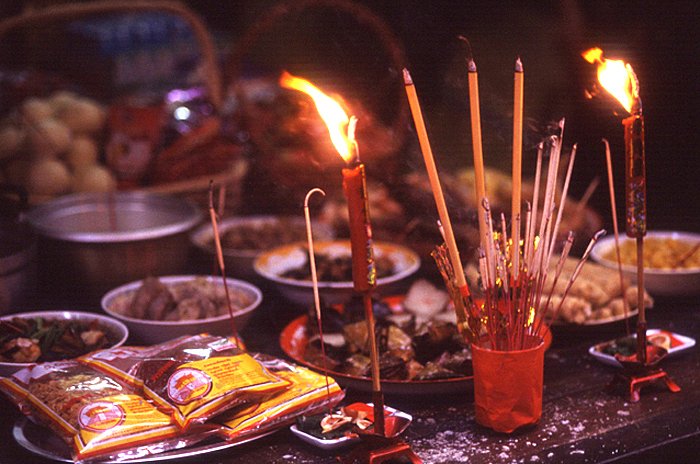Offerings
Credits: Nations Online (http://www.nationsonline.org/album/Chinese_New_Year/slides/slideshow_China_Town_Bangkok_h022.html)The Chinese generally put up offerings for the deceased on two occasions: The Qing Ming Festival and Ghost Festival. The Qing Ming Festival, also known as the Tomb Sweeping Day, occurs on the 15th day from the Spring Equinox. It is an occasion when the Chinese visit and honour their ancestors at gravesites, offering before their ancestors, food, tea, wine, utensils, prayers etc. Paper offerings, which includes joss paper and paper replica of material goods such as cars, home phones, are always burn before the ancestors, because the Chinese believe that the spirits will be able to receive these goods in the afterlife..
During the Ghost Festival which takes place during the Ghost month, or the seventh month in the lunar calendar, the Chinese believe that the realms of the spiritual world (Heaven and Hell) will open. During the duration of the Ghost month, the Chinese would prepare food offerings, incense, and paper offerings for the visiting spirits of their ancestors and all deceased in general. In Singapore, getai or concert-like performances are held throughout the duration of the whole month for the living and the dead. Before these getai stages, there will always be a row of empty seats reserved for the visiting spirits of the dead.
The Chinese believe that by burning offerings before their ancestor’s grave or ashes, their ancestors in the spiritual realm would receive these offerings. For example, joss paper or hell money when burned, are believed to be converted to banknotes which can be used in the netherworld. Hell money is therefore burnt to ensure that the spirit of the deceased will have lots of wealth and good things in the afterlife.
Other paper offerings include过 路钱,a small stack of beige rectangular shaped paper with three holes punched onto them, believed to be the ‘money’ used by the deceased when they travel from places to places in the underworld, akin to the road tolls when travelling in large countries.
In addition, there is the往 生纸, yellow papers with scriptures written on them, which are burnt so that the deceased will be quickly queued up for reincarnation in the underworld, given that religious Chinese believe in reincarnation.
In recent years, more shops are selling new forms of paper offerings. For example, house models made out of paper are burnt to ensure that ancestors have a place to live in the underworld. Realistic paper models of cars and food items are also burnt as offering. Surprisingly, more and more families now burn IT gadgets like the iPhone and iPad when they pray before their ancestors.
During QingMing, families often scatter coloured paper of five colours over the grave of their ancestors. While these paper offerings are not to be burnt, they actually represent real flowers, often orchids, as offerings for the dead.
Joss sticks or incense burning is an everyday practice for the traditional Chinese. Different kinds of joss sticks can be burnt as an offering to the dead for different purposes and on different festive days, to express respect for the deceased. Candles, normally red, are also lit before gravesites as a commemoration of the dead.
